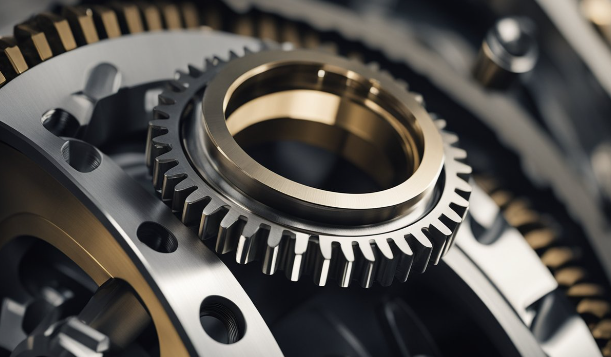Gear Backup Ring: What It Is and Why You Need It
If you're in the market for seals, you may have heard of gear backup rings. These rings are used to prevent extrusion in high-pressure applications and are often used in conjunction with O-rings. The rings are washer-like devices that are installed downstream of the gland and are designed to prevent a seal from extruding through any gaps while under pressure.
Back-up rings are not seals themselves, but they offer support to the primary seal, especially under high-pressure conditions. They are typically made from thermoplastic materials like virgin or filled PTFE (polytetrafluoroethylene) or high-performance thermoplastics like PEEK (Polyether ether ketone). These rings are designed to close off the sealing system's extrusion gap and prevent the migration of sealing material into the extrusion gap under system pressure.
In this article, we'll explore gear backup rings in more detail, including their design, materials, and applications. We'll also discuss the benefits of using backup rings in your sealing system and provide tips on how to select the right backup ring for your application. Whether you're new to the world of seals or you're a seasoned professional, this article will provide valuable insights into gear backup rings and their role in high-pressure applications.
Gear Backup Ring Basics
Definition and Function
Gear backup rings are mechanical components that are used to prevent the extrusion of an O-ring seal in high-pressure applications. They are used in conjunction with O-rings to provide additional support and prevent the O-ring from being forced out of the sealing groove. Gear backup rings are typically made from a rigid material such as PTFE or nylon and are designed to fit snugly against the O-ring, providing an additional barrier to prevent extrusion.
Material Composition
Gear backup rings are typically made from a variety of materials, including PTFE, nylon, and other thermoplastics. PTFE is a popular choice for gear backup rings due to its chemical resistance and ability to withstand a wide range of temperatures. Nylon is also a popular material choice for gear backup rings as it provides excellent strength and durability.
Types and Variants
There are several different types of gear backup rings available, each designed to meet specific application requirements. Some common types of gear backup rings include:
- Straight-cut backup rings: These rings are designed with a straight-cut profile and are typically used in static applications.
- Scarf-cut backup rings: These rings are designed with a diagonal cut profile and are commonly used in dynamic applications.
- Spiral-cut backup rings: These rings are designed with a spiral cut profile and are typically used in high-pressure applications.
In addition to these standard types of gear backup rings, there are also specialized variants available, including custom-designed backup rings and backup rings with special coatings or surface treatments.
Overall, gear backup rings are an essential component in high-pressure sealing applications, providing additional support and preventing O-ring extrusion. By choosing the right type of gear backup ring for your application and ensuring proper installation, you can help ensure a reliable and long-lasting seal.
Design Considerations
When designing a gear backup ring, there are several key considerations to keep in mind. These include dimensional specifications, compatibility with different gears, and temperature and pressure limits.
Dimensional Specifications
One of the most important considerations when designing a gear backup ring is ensuring that it meets the appropriate dimensional specifications. This includes factors such as the inner and outer diameter of the ring, as well as the thickness of the ring itself. It is important to ensure that the dimensions of the backup ring are compatible with the specific gear it will be used with, as well as any other components that may be involved in the system.
Compatibility with Different Gears
Another important consideration when designing a gear backup ring is ensuring that it is compatible with different types of gears. This includes both internal and external gears, as well as gears with different numbers of teeth. It is important to ensure that the backup ring is designed to work with the specific gear it will be used with, and that it is capable of providing the necessary support and protection.
Temperature and Pressure Limits
Finally, it is important to consider the temperature and pressure limits of the gear backup ring. This includes factors such as the maximum temperature and pressure the ring can withstand, as well as any other environmental factors that may impact its performance. It is important to ensure that the backup ring is designed to withstand the specific conditions it will be exposed to, in order to ensure optimal performance and longevity.
Overall, when designing a gear backup ring, it is essential to carefully consider all of these factors in order to ensure that the ring is capable of providing the necessary support and protection to the gear system. By taking the time to carefully design and select the appropriate backup ring, you can help to ensure that your gear system operates smoothly and reliably over the long term.
Installation and Maintenance
Proper Installation Techniques
Proper installation of the gear backup ring is critical to ensure its effectiveness and longevity. Before installation, inspect the ring for any damage or defects. Ensure that the ring is the correct size and material for the application.
During installation, make sure that the ring is properly seated in the groove. Use a proper installation tool to avoid damaging the ring during installation. Be sure to follow the manufacturer's recommended installation procedures.
Common Maintenance Practices
Regular maintenance is essential to ensure the proper functioning of the gear backup ring. Inspect the ring regularly for signs of wear, damage, or extrusion. Replace the ring if any of these signs are present.
Clean the ring and the groove thoroughly during maintenance to prevent the buildup of debris or contaminants. Use a non-abrasive cleaner and a soft brush to avoid damaging the ring or the groove.
Troubleshooting Common Issues
If you are experiencing issues with the gear backup ring, there are a few common problems that you can troubleshoot. One common issue is extrusion of the ring. This can be caused by high pressure or improper installation. Check the installation and the pressure to ensure that they are within the manufacturer's recommended parameters.
Another common issue is wear or damage to the ring. This can be caused by excessive use or exposure to harsh conditions. Inspect the ring regularly and replace it if any signs of wear or damage are present.
By following proper installation techniques, performing regular maintenance, and troubleshooting common issues, you can ensure the proper functioning of your gear backup ring.
Performance and Reliability
Wear and Lifespan
Gear backup rings play a critical role in ensuring the reliability and performance of high-pressure hydraulic systems. They help to ensure the integrity of seals used within these pressurized systems, which leads to reduced leakage and a longer lifespan for components.
The lifespan of a gear backup ring depends on various factors, such as the material used, the operating conditions, and the design of the ring. For instance, backup rings made from thermoplastic materials like PTFE (polytetrafluoroethylene) or high-performance thermoplastics such as PEEK (Polyether ether ketone) are known for their excellent wear resistance and long lifespan.
To ensure the longevity of gear backup rings, it's essential to follow proper installation procedures and maintenance practices. Regular inspection and replacement of worn-out backup rings can help prevent system failure and reduce downtime.
Testing and Quality Assurance
To ensure optimal performance and reliability, gear backup rings undergo rigorous testing and quality assurance procedures. These procedures include material testing, dimensional inspection, and performance testing under various operating conditions.
Material testing involves testing the mechanical properties, chemical resistance, and thermal stability of the backup ring material. Dimensional inspection ensures that the backup ring meets the required specifications and tolerances.
Performance testing involves evaluating the performance of the backup ring under various operating conditions, such as pressure, temperature, and speed. This testing helps to ensure that the backup ring can withstand the harsh conditions of the hydraulic system and provide reliable sealing performance.
In conclusion, gear backup rings are critical components of high-pressure hydraulic systems, and their performance and reliability are essential for the safe and efficient operation of these systems. By following proper installation procedures, maintenance practices, and quality assurance procedures, you can ensure the optimal performance and longevity of gear backup rings.
Regulatory and Safety Standards
Industry Compliance
When it comes to gear backup rings, it is important to ensure that they meet industry compliance standards. These standards are in place to ensure that the gear backup rings are safe, reliable, and effective in their intended use.
One of the most important industry compliance standards for gear backup rings is ISO 3601. This standard specifies the dimensions, tolerances, and materials for O-rings and their associated backup rings. By adhering to this standard, manufacturers can ensure that their gear backup rings are compatible with a wide range of applications and meet the necessary safety requirements.
Safety Protocols
In addition to industry compliance standards, there are also safety protocols that should be followed when using gear backup rings. These protocols are designed to ensure that the rings are used safely and effectively, and that any potential hazards are minimized.
One important safety protocol is to ensure that the gear backup rings are installed correctly. This involves ensuring that the rings are the correct size and material for the application, and that they are installed in the correct orientation. It is also important to ensure that the rings are not damaged during installation, as this can compromise their effectiveness.
Another important safety protocol is to regularly inspect the gear backup rings for signs of wear or damage. This can include looking for cracks, tears, or other forms of damage that could compromise the integrity of the ring. By regularly inspecting the rings, you can ensure that they are functioning properly and that any potential hazards are identified and addressed in a timely manner.
Overall, by adhering to industry compliance standards and following the necessary safety protocols, you can ensure that your gear backup rings are safe, reliable, and effective in their intended use.

